ASUS Zenbook Prime (UX21A) Review: The First of the 2nd Gen Ultrabooks
by Anand Lal Shimpi on May 22, 2012 2:46 PM EST- Posted in
- Laptops
- CPUs
- Asus
- Ivy Bridge
- Zenbook
- Zenbook Prime
- Ultrabook
- Notebooks
The Display in Numbers
The new 1080p panel looks good, but does it make any sacrifices in its performance? Thankfully, no. Max brightness is down a bit compared to the previous generation, but it's still higher than any of the portable Macs and much higher than your typical PC displays. Black levels are much improved over the original Zenbook as well:
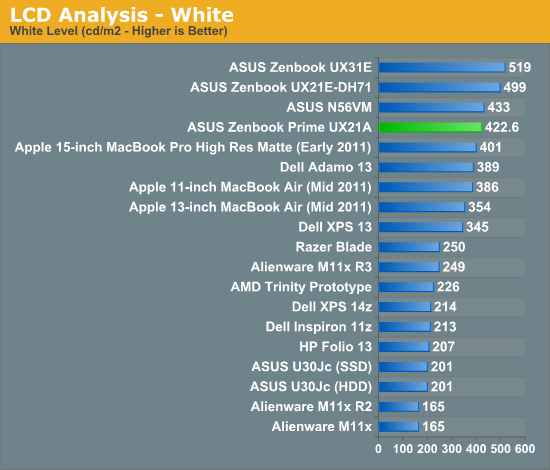
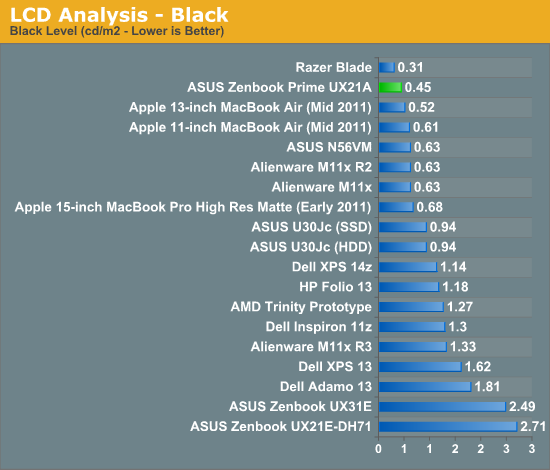
The resulting contrast ratio is almost tablet-like:
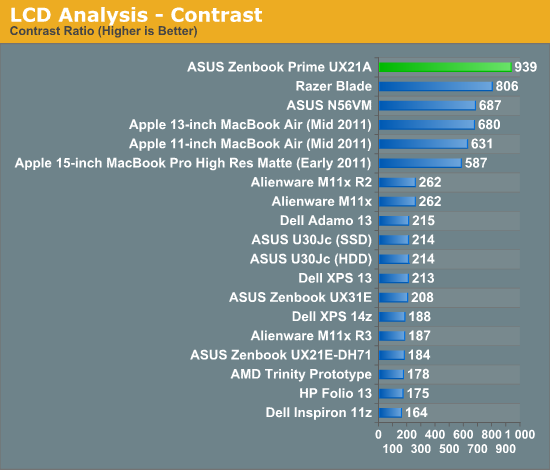
It's not just the basics that ASUS delivers well on, color accuracy is top notch:
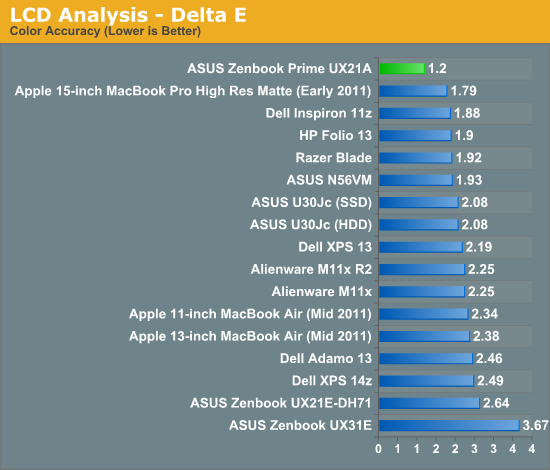
Color gamut is shy of the MacBook Pro but much better than the previous Zenbook and the MacBook Air:
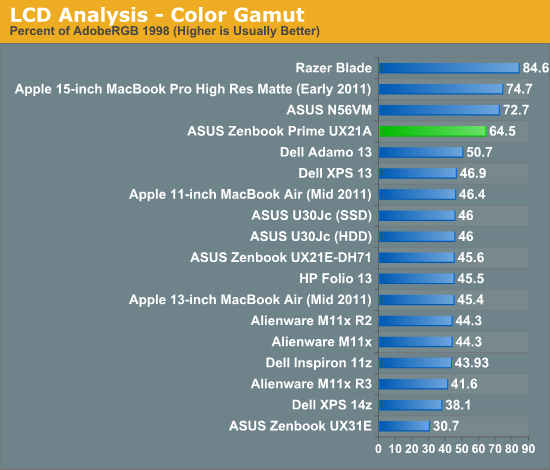
Size is definitely an issue here. While I think the 1920 x 1080 panel will be a very good fit for the 13.3-inch UX31, there's a smaller subset of folks who are going to appreciate it in the 11.6-inch UX21. Personally I think it's fine but at 189 PPI the 11-inch Zenbook Prime is going to be a tough sell for those who have a tough time looking at small text.
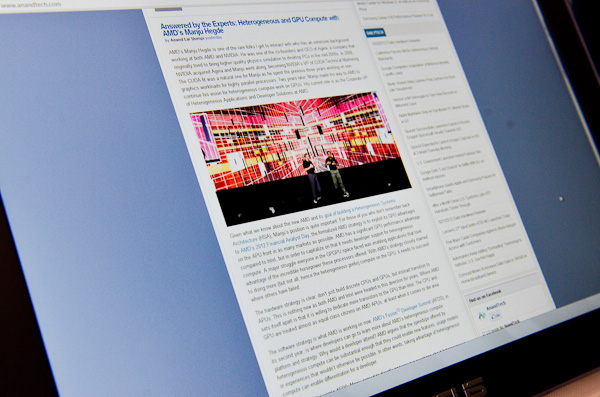
Text on the 11-inch 1080p panel
ASUS' solution is to ship the UX21 with Windows set to 125% DPI scaling by default, unfortunately most applications (including many of Microsoft's own) don't deal with non-integer DPI scaling very well.
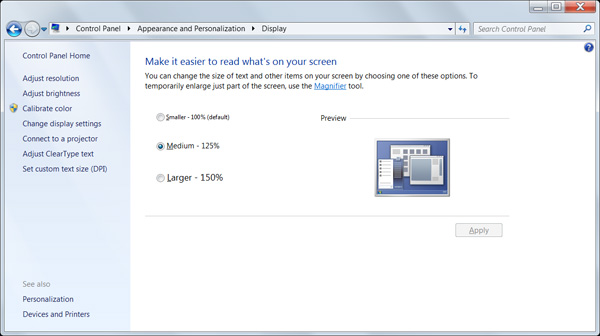
Here's what the default desktop looks like at 125%:
And here are examples of applications that don't behave well with Windows 7's DPI scaling:
In Skype, some text elements are tiny while others are huge. PCMark Vantage is an example of where you see this as well:
Here the scaled text actually can't fit in the area allocated for it, while the rest of the text is entirely too small.
There's not much you can do to work around this today with Windows 7. You're either going to have really small text or have to deal with funny scaling. This is unfortunately a major downside to not controlling the OS layer, ASUS is at the mercy of Microsoft to get scaling for displays with high pixel densities right. Windows 8 should be better in this regard but I ran out of time to try it out on the Zenbook Prime before the embargo lift.




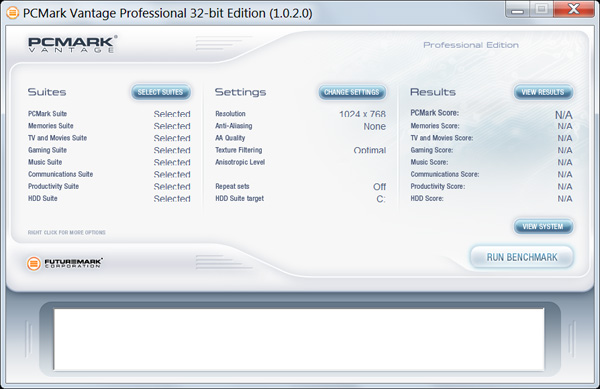








192 Comments
View All Comments
puppies - Tuesday, May 22, 2012 - link
Name a single game that you will run on this product that uses more than 4GB of RAM.Your usage needs are so far from the norm that you might aswell forget finding something that satifies your criteria.
Or is this some weak attempt at trolling by pointing out what a low power ultra book can't do because it was never designed to do it in the first place.
r3loaded - Tuesday, May 22, 2012 - link
"ASUS, people do more than web surf and face book on their laptops."Actually, that's what the vast majority of people do. What, you thought those spoilt students with MBPs were using them for computationally intensive tasks?
ImSpartacus - Wednesday, May 23, 2012 - link
I can vouch that most users do just that. We can include this user as well (with his MBP). >_>rosege - Thursday, May 24, 2012 - link
I agree - hence im looking at the UX32VD-DB71 - though would really have liked 8GB - think the onboard should have been 4 then have the option to add another 4only 4gb in the other models is a major weakness imho
sheltem - Tuesday, May 22, 2012 - link
Why can't Asus just include two mini displayports and call it a day? I understand why people still use full size VGA, but mini VGA is just retarded; you're going to need a dongle anyway.MobiusStrip - Tuesday, May 22, 2012 - link
That is pretty annoying. A DP-to-HDMI adapter is under $5.ka_ - Tuesday, May 22, 2012 - link
Not sure but I understand Displayport essentially is the same as thunderbolt which essentially let any connected device bypass the entire security of your system the same way firewire did, so no thanks until that issue is resolved.I do agree however that having mini connectors - expecially for HDMI which already is small is a worry. Most mini-firewire connectors I have had in the past failed over time as I happen to bring my machine back and forward to work and clients. I think I will connect a screen way more frequently than I connected my external Firewire devices in the past.
VGA I understand had to be shrunk here, but why shrink the already small HDMI port?
Kevin G - Tuesday, May 22, 2012 - link
Thunderbolt tunnels PCI-e which has access to memory as any add-on board would. DisplayPort on the other hand mainly handles video output with options for audio and basic IO tunneling (think keyboard, mouse, touch screen etc.).Penti - Wednesday, May 23, 2012 - link
DisplayPort has nothing to do with Thunderbolt you freaking egghead! It's not connected to any system bus. When used in conjunction with Thunderbolt (PCIe) it uses a cable that carries both signals in the same Thunderbolt (Not DP!) cable. DP-devices can however never connect to the Thunderbolt hardware, which is why it also costs quiet a bit. You can get your normal TMDS SINGLE/DUAL-LINK DVI-D, VGA, HDMI or just plain digital DisplayPort via adapters as it's all compatible with those. A DisplayPort to HDMI cable, or DVI (same signal no sound) or adapter costs nothing and comes included in many computers or graphics adapters. All modern monitors uses it now and there are adapters and converters for legacy stuff as well. Most modern GPU's don't have the option to have dual or quad dual-link DVI any more. I also don't know why you would like to clutter up your notebook with 3-4 different ports that will need cables and so on any way.There are no issues to be resolved with Thunderbolt any other extension involving system buses has worked the same way, there are eventually software fixes to be had, but we will not fully virtualize the address space here and just as we can shut off USB-ports enterprises will probably be able to shut off Thunderbolt functionality in firmware. However they are essentially invisible PCIe switches now that the firmware doesn't touch and that is it's strength. It's no different then to put in an Expresscard accessory in your computer. If you have physical access you have physical access, you could just as well open it up and connect to the PCIe bus of the Mini PCI-Express slot. You also don't need the DMA-vector for cold boot attacks against your encrypted hard drive so it is an entirely pointless discussion. Plus it's just as hard to use as a attack and delivery mechanism as any internal PCIe chip is. You better not use any add in boards in stationary computers either I guess. This is not an Apple we don't ask for DisplayPort for the sake of DP + Thunderbolt, we ask for it because it is the only modern video interface and is natively compatible (well the gpus are, and the cabling can be adapted to whatever you need and are designed to carry those signals) with HDMI, DVI and VGA. Which is all you need. You do need DisplayPort, or a business laptop with a docking station and dual-link DVI support or active DisplayPort to dual-link DVI converter to drive anything over 1920x1200 on a laptop (3GHz HDMI 1.4a will go higher and is supported as of very lately but not by computer displays yet.). You can't try to force all that through a HDMI-connector with the same universal compatibility, versatility, better to have two mini-DP's if you like to drive a couple of displays without daisy-chaining.
KZ0 - Tuesday, May 22, 2012 - link
Truly impressive. Just DPI scaling remaining, then. Only thing holding me back is that I can't really complain about my current computer.